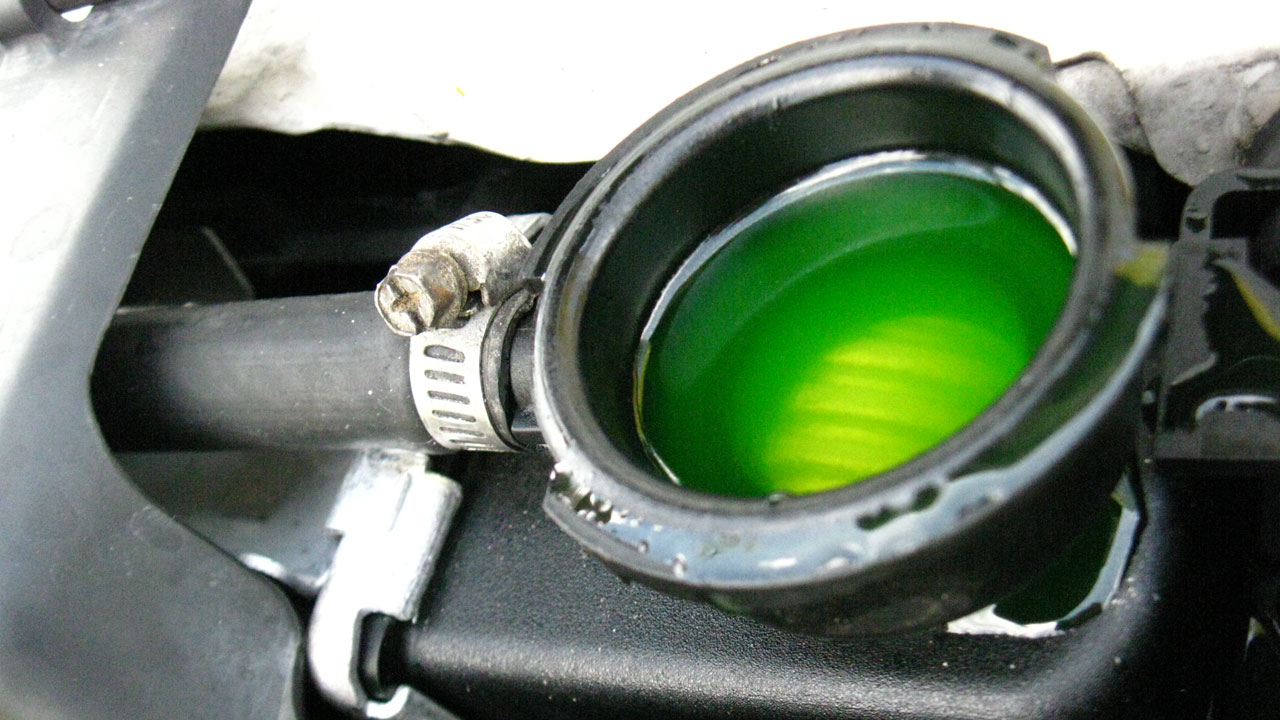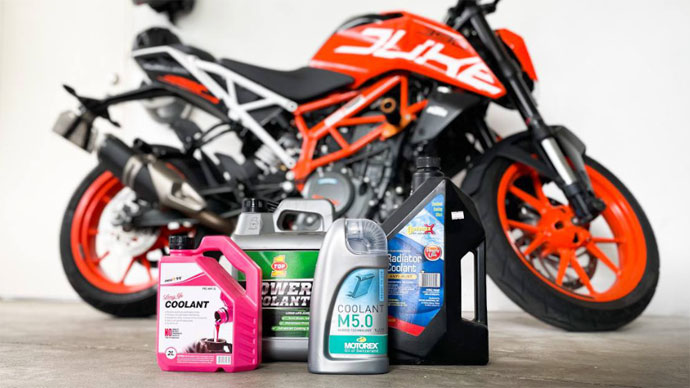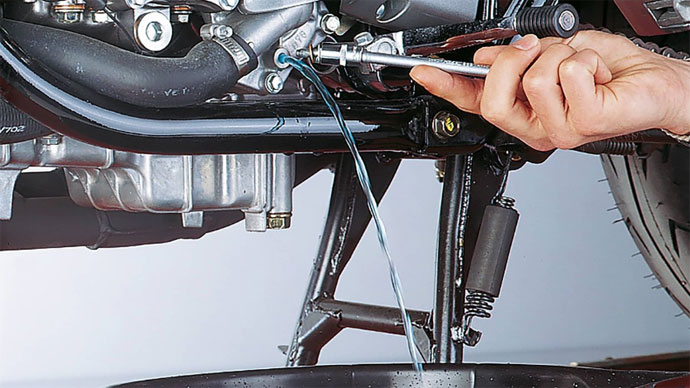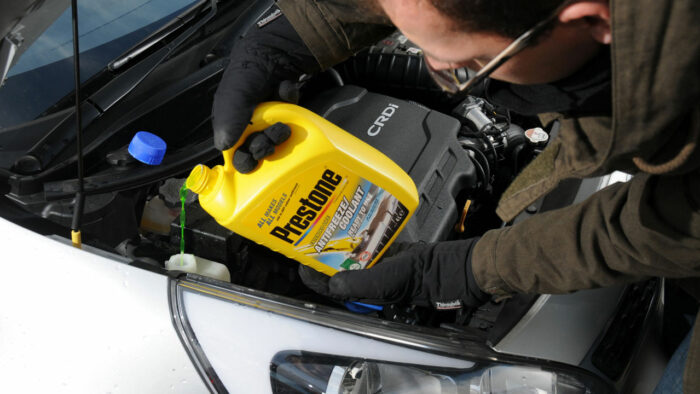Do you have some leftover car coolant in the garage? Are you wondering if car coolants can be used in motorcycles? Do you feel the use of car coolant in a motorcycle would have adverse effects?
It’s time to find out. In this article, we will be answering the question “Can you use car coolant in a motorcycle” to every last detail.
What Is a Car Coolant?
A car coolant, also known as antifreeze, is a colored liquid, usually mixed with water, that serves the purpose of regulating a vehicle’s engine during extreme temperatures. Whenever there is an increase in temperature as your motorcycle travels, the coolant is pumped throughout the engine block to prevent an uneven operating temperature.
Antifreeze for motorcycles is a multi-purpose, colored fluid that not only prevents heat generation and uneven temperatures but also prevents corrosion in the engine block.

Can You Use Car Coolant in a Motorcycle?
Yes, you can use antifreeze designed for cars as a coolant for motorcycles. It doesn’t cause any damage to your motorcycle, but it is also not advisable to mix up different coolants with different colors as this may have adverse effects on your motorcycle.
Car coolants and antifreeze for motorcycles have the same compositions, but there are some companies that produce coolants for specific vehicles and these should not be used as coolants for motorcycles. Another point to note is that you should never mix up coolants with different colors.
READ ALSO: How to Detect Odometer Rollback on a Used Vehicle
What Should I Check for in Coolant for Motorcycles?
There are three major things you should look out for before you use that coolant on your motorcycle. They are
- Presence of antifreeze.
- Fluidity.
- Toxicity
Presence of Antifreeze
Before you use that car coolant on a motorcycle, you have to be sure it can actually work as a coolant by checking for its antifreeze properties. There are basically two types of coolants for motorcycles and cars and they are popular amongst motorcycle riders- propylene glycol and ethylene glycol.
Ethylene Glycol Coolants for Motorcycles
Ethylene glycol for motorcycles is extremely useful and recommended. Compared to propylene glycol, ethylene glycol is more effective and has superior heat transfer efficiency, lower viscosity, and flammability. Although the use of ethylene glycol for motorcycles is advised, it is important to note that ethylene is highly toxic and destroys the liver when consumed.
Fluidity
A good property of a coolant used in a motorcycle should be fluidity. Your coolant should be able to flow at all times and not form a thick layer between the engine’s outer layer and the environment. In some cases, fluidity is also termed layer thickness. So ensure to check the layer thickness before using that.
Toxicity
Some coolants are composed of dangerous and harmful substances. Ensure that the coolant type selected provides no harm to you, your motorcycle, and the environment at all times. Avoid direct contact with eyes and skin, and do not consume.
If you are new to using coolants, it’s best you stick with the normal coolants for motorcycles to prevent damage.
Did you know that you could run a VIN check on your motorcycle with a Vehicles Report? All you need to do is provide your Vehicle Identification Number and that’s it. Click here to begin the process.

Can I Use Water As a Coolant for My Motorcycle?
Some people wonder if distilled water can serve as a coolant in motorcycles and even cars. We’d like to inform you that this is wrong. Remember we highlighted three things to look out for in coolants and one of them is the presence of an antifreeze.
- Distilled water has no antifreeze and cannot be equivalent in any way to ethylene glycol. Ethylene glycol prevents ice crystal formation in the motorcycle. Introducing water here may even make things worse because, in low temperatures, water will form ice crystals and destroy the engine of your vehicle- a motorcycle or car.
- Antifreeze for motorcycles and cars contains anti-corrosive additives while water has none. Moisture causes corrosion and this is a known fact. Using water as a coolant in a motorcycle increases the risk of corrosion in the motorcycle.
How to Check The Coolant Level in My Motorcycle?
How do you check the level of the coolant in a motorcycle? Easy. There are four simple steps that you can follow to check the coolant level in your motorcycle. They are:
Find the Coolant Reservoir in Your Motorcycle
The coolant reservoir is located near the fuel tank, just below the radiator. If you don’t find it there, then you should go through the manufacturer’s manual of your motorcycle.
Prepare the Motorcycle
The next step here is to place the motorcycle in an upright position as this would increase the accuracy of the process. You could lean the motorcycle against the wall or have someone hold it for you.
Check the Level
With the motorcycle properly positioned, you can now check the level of your motorcycle’s coolant. Ensure that the motorcycle is cool before touching anything. We recommend that you put your safety first above any other thing.
Pour in Coolant
If the level of coolant in your motorcycle is low, proceed to pour in the coolant. Check the reservoir’s indicator to know when you put in enough coolant. After pouring the coolant, ensure that the reservoir is properly shut.
How to Properly Maintain and Flush your Motorcycle Coolant System?
Now let’s look at the steps to properly maintain and flush your motorcycle coolant system.
- Make sure your motorcycle is cooled off.
- Take out existing bodywork.
- Inspect the radiator and hoses.
Drain the motorcycle radiator fluid (coolant). - Flush the radiator with a hose and water.
- Pour in the motorcycle radiator fluid (coolant).
- Turn on the motorcycle with the radiator cap off to free trapped air.
- Blip the throttle and rock the motorcycle gently to help free any air.
- Reinstall any bodywork.
That’s all. If you followed the steps above, then you would have properly maintained and flushed the coolant system of your motorcycle.
READ ALSO: The Alfa Romeo VIN decoder
How to Safely Dispose of Used Coolant From Your Motorcycle?
After pouring out the used coolant from your motorcycle, you would face the question of how and where to dispose of the toxic fluid. Well, simply put, recycle it. Don’t pour it down the drain, don’t pour it on the ground as it is harmful to pets, and take it to the nearest local recycling center, service station, or auto repair shop. Some auto repair shops may not be willing to help you dispose of used coolant so you could keep searching till you find one.

Final Words
Conclusively, in this article, we discovered the answer to the question “Can You Use Car Coolant In a Motorcycle?” and we learned that car coolants can be used in motorcycles as long as they are ethylene glycol-based coolants. Also, note that it is not recommended to mix up coolants with different colors as this could cause severe damage to your motorcycle and yourself. Overall, let safety be at the back of your mind in whatever you do.








